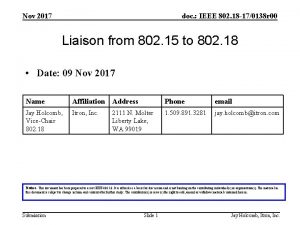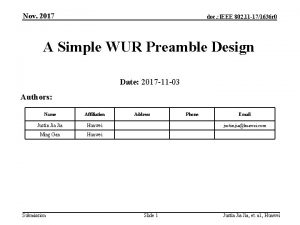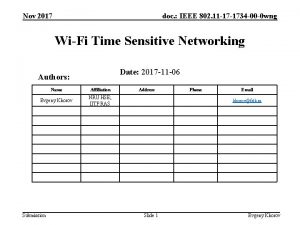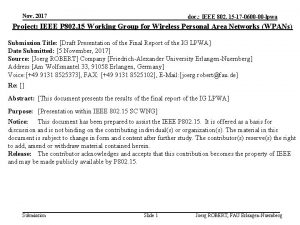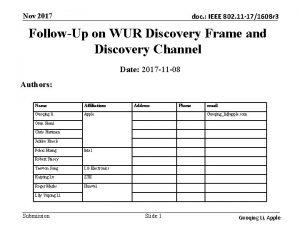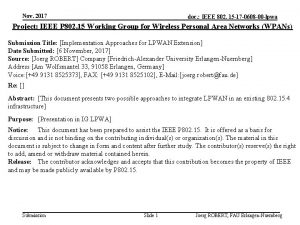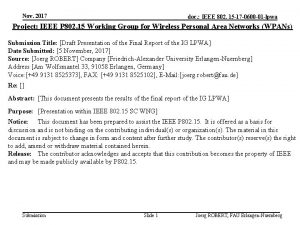NOV 2017 doc IEEE 802 11 171655 r









- Slides: 9

NOV 2017 doc. : IEEE 802. 11 -17/1655 r 0 DCM SQPSK for channel aggregation in OFDM mode Date: 2017 -11 -06 Authors: Slide 1 LG

NOV 2017 doc. : IEEE 802. 11 -17/1655 r 0 Introduction • SQPSK modulation for channel aggregation is not defined in current draft • This presentation investigate several options for DCM SQPSK modulation for channel aggregation (2. 16 GHz+2. 16 GHz or 4. 32 GHz+4. 32 GHz) in OFDM mode and propose a method with better performance Slide 2 LG

NOV 2017 doc. : IEEE 802. 11 -17/1655 r 0 Simulation Assumption • • Channel aggregation(2. 16 GHz+2. 16 GHz or 4. 32 GHz+4. 32 GHz) SISO transmission 11 ad CR, CB NLOS channel model Ideal channel estimation 11 ad LDPC code(1/2) PPDU length 8192 bytes Static Tone Pairing(STP) subcarriers mapping Receiver Algorithm : MRC in frequency domain Slide 3 LG

NOV 2017 doc. : IEEE 802. 11 -17/1655 r 0 Option 1 : SQPSK in each aggregated channel • The first half of data symbols are mapped to the first half of channel 1. Its conjugated repetitions are mapped to second half of the channel 1 • The second half of data symbols are mapped to the first half of channel 2. Its conjugated repetitions are mapped to the second half of the channel 2 168 data symbols Bits[2 m, 2 m+1] S(m) S(n) conj(S(m)) 168 subcarriers Aggregated channel 1 conj(S(n)) Slide 4 168 subcarriers Aggregated channel 2 LG

NOV 2017 doc. : IEEE 802. 11 -17/1655 r 0 Option 2 : SQPSK across the aggregated channels 336 data symbols Bits[2 m, 2 m+1] S(m) conj(S(m)) S(n) conj(S(n)) 336 subcarriers Aggregated channel 1 Aggregated channel 2 Slide 5 LG

NOV 2017 doc. : IEEE 802. 11 -17/1655 r 0 Simulated PER of DCM SQPSK • 11 ad CB channel • SNR gain at 1% and 0. 1% PER Option 1 Option 2 Gain 1% -1. 48 d. B -1. 46 d. B ~0. 02 d. B 0. 1% -1. 2 d. B -1. 1 d. B ~0. 1 d. B Slide 6 LG

NOV 2017 doc. : IEEE 802. 11 -17/1655 r 0 Simulated PER of DCM SQPSK • 11 ad CR channel • SNR gain at 1% and 0. 1% PER Option 1 Option 2 Gain 1% 0. 75 d. B 1. 07 d. B ~ 0. 4 d. B 0. 1% 1. 87 d. B 2. 63 d. B ~0. 8 d. B Slide 7 LG

NOV 2017 doc. : IEEE 802. 11 -17/1655 r 0 Conclusion • In this contribution, we compared the performance of – Option 1 : SQPSK modulation in each aggregated channel – Option 2 : SQPSK modulation across the aggregated channels • Based on simulation, option 2 have better performance – 11 ad CB : 0. 02 d. B @ 1% PER, 0. 1 d. B @ 0. 1% PER – 11 ad CR : 0. 4 d. B @ 1% PER, 0. 8 d. B @ 0. 1% PER • We propose that DCM SQPSK modulation across the aggregated channels may be used for OFDM transmission mode Slide 8 LG

NOV 2017 doc. : IEEE 802. 11 -17/1655 r 0 SP • Do you agree – to define DCM SQPSK across aggregated channels as described in (11 -171656 -00 -00 ay-Draft text for DCM SPQKS for channel aggregation in OFDM mode)? Slide 9 LG










